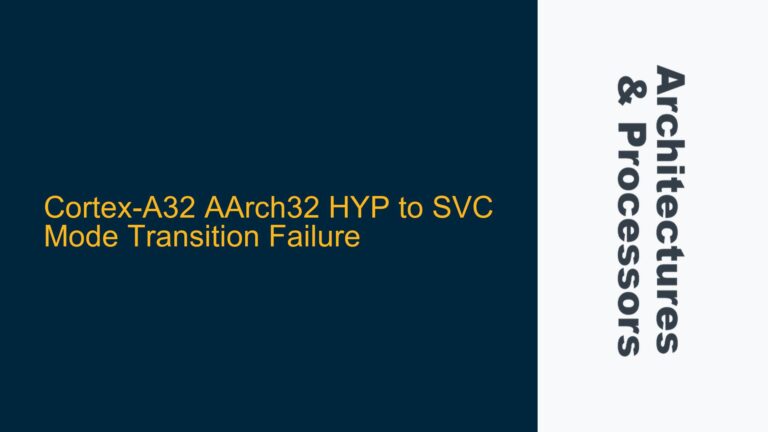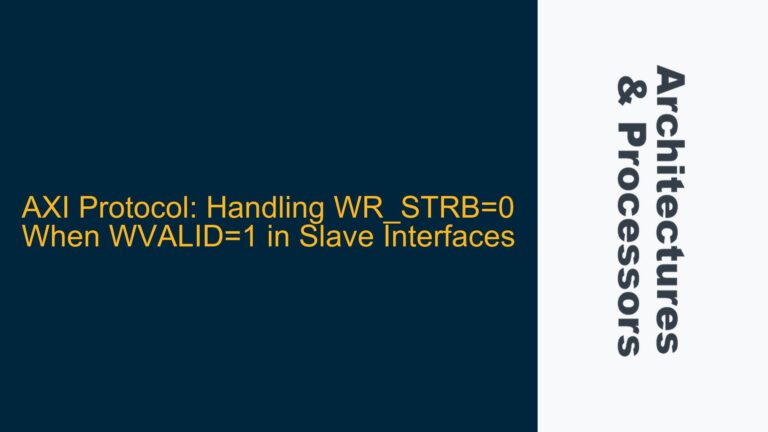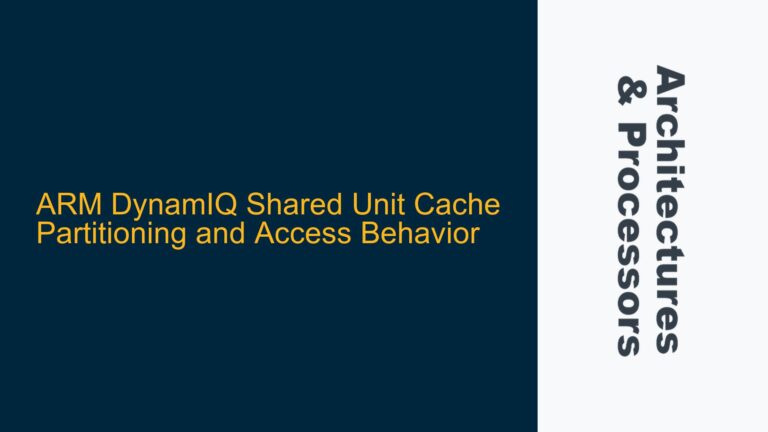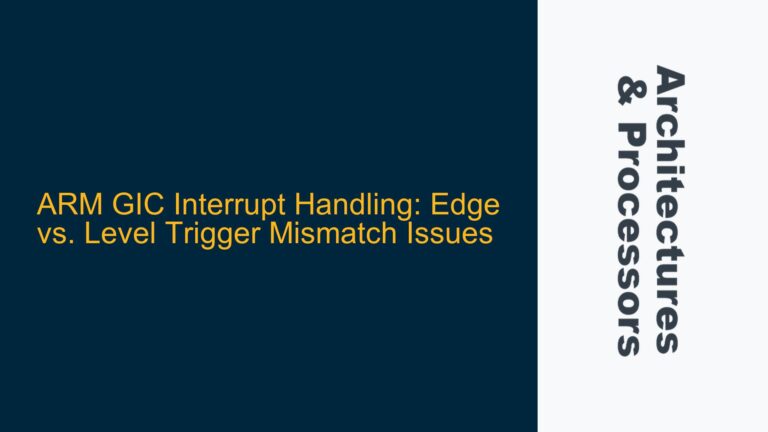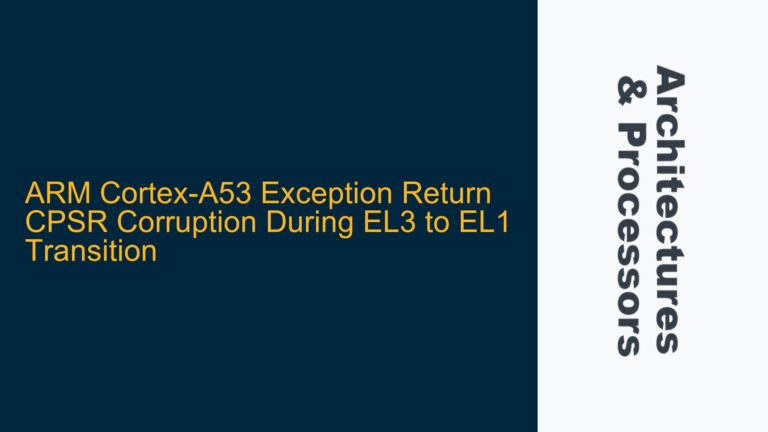ARM Cortex-A53 MMU Translation Table Misconfiguration in Flat-Mapped Memory
The ARM Cortex-A53 processor, a widely used 64-bit core in embedded systems, relies heavily on the Memory Management Unit (MMU) for virtual-to-physical address translation and memory protection. A critical aspect of MMU configuration is the setup of the translation table, which defines memory attributes and access permissions for different regions of the address space. In this case, the translation table is flat-mapped, meaning virtual addresses are identical to physical addresses, but the memory attributes are explicitly defined for different regions such as DDR, PL, QSPI, and others. The provided assembly code for the translation table setup reveals potential issues in memory attribute configuration, alignment with hardware design, and proper handling of reserved or unassigned regions. Misconfigurations in these areas can lead to translation faults, cache coherency issues, or improper memory access behavior.
The translation table uses the short descriptor format, where each entry covers a 1MB section of memory. The table is divided into regions with specific attributes, such as Normal Write-Back Cacheable for DDR, Strongly Ordered for PL, and Device Memory for peripherals like QSPI and PCIe. However, the implementation raises concerns about the handling of reserved regions, alignment with the actual hardware memory map, and the potential for translation faults if the DDR size is less than 2GB. Additionally, the use of hardcoded values and conditional compilation based on DDR size introduces complexity that may lead to runtime errors if not carefully validated.
Memory Attribute Mismatch and Reserved Region Handling
One of the primary issues in the translation table setup is the potential mismatch between memory attributes and the actual hardware design. The table defines regions such as DDR (0x00000000 – 0x7FFFFFFF) as Normal Write-Back Cacheable, which is appropriate for general-purpose memory. However, if the DDR size is less than 2GB, the region between the end of DDR and the start of PL (0x80000000) is marked as unassigned or reserved. This can lead to translation faults if software inadvertently accesses these regions. The assembly code attempts to handle this by calculating the DDR_REG and UNDEF_REG values dynamically, but the logic assumes a specific hardware configuration that may not always be valid.
Another concern is the handling of device memory regions, such as QSPI and PCIe, which are marked as Device Memory. Device memory attributes are crucial for ensuring proper behavior when accessing peripherals, as they disable caching and enforce strict ordering. However, the table does not explicitly account for potential variations in peripheral memory maps across different hardware designs. For example, the region 0xF8000000 – 0xF8FFFFFF is marked as Device Memory for STM Coresight, but this may not align with the actual memory map in all implementations. Similarly, the region 0xFFC00000 – 0xFFDFFFFF is marked as Device Memory for CSU and PMU, but this assumes a specific hardware configuration that may not be universal.
The translation table also includes regions marked as unassigned or reserved, such as 0xF0000000 – 0xF7FFFFFF and 0xF9100000 – 0xFCFFFFFF. These regions are configured to generate translation faults if accessed, which is a reasonable approach for preventing unintended access. However, the table does not provide a mechanism for dynamically adjusting these regions based on the hardware design. This can lead to issues if the hardware includes additional peripherals or memory regions that are not accounted for in the table.
Implementing Robust Translation Table Configuration and Validation
To address these issues, the translation table setup should be enhanced to ensure robust configuration and validation. First, the memory attributes for each region should be carefully aligned with the hardware design. This includes verifying the DDR size and ensuring that the region between DDR and PL is properly marked as unassigned or reserved. The assembly code should be updated to handle cases where the DDR size is less than 2GB, ensuring that the UNDEF_REG value is correctly calculated and applied.
Second, the handling of device memory regions should be made more flexible to accommodate variations in hardware designs. This can be achieved by using conditional compilation or runtime configuration to adjust the memory attributes based on the specific hardware implementation. For example, the memory attributes for STM Coresight, CSU, and PMU should be configurable to align with the actual memory map.
Third, the translation table should include a mechanism for dynamically adjusting unassigned or reserved regions based on the hardware design. This can be achieved by using a combination of conditional compilation and runtime configuration to ensure that these regions are properly marked and aligned with the hardware memory map. Additionally, the table should include error handling to detect and report translation faults, providing valuable debugging information in case of misconfiguration.
Finally, the translation table setup should be thoroughly validated to ensure that it aligns with the hardware design and provides the desired memory attributes and access permissions. This includes testing the table with different hardware configurations, verifying the behavior of device memory regions, and ensuring that unassigned or reserved regions generate translation faults as expected. By implementing these enhancements, the translation table setup can be made more robust and reliable, reducing the risk of runtime errors and improving system performance.
Detailed Troubleshooting Steps for ARM Cortex-A53 MMU Configuration
Step 1: Verify DDR Size and Alignment
The first step in troubleshooting the translation table setup is to verify the DDR size and alignment. The assembly code uses the DDR_REG and UNDEF_REG values to define the DDR and unassigned regions, but these values are based on assumptions about the hardware design. To ensure correctness, the DDR size should be explicitly defined in the hardware configuration and validated against the actual memory map. If the DDR size is less than 2GB, the UNDEF_REG value should be calculated to ensure that the region between DDR and PL is properly marked as unassigned or reserved.
Step 2: Validate Memory Attributes for Device Regions
The next step is to validate the memory attributes for device regions, such as QSPI, PCIe, STM Coresight, CSU, and PMU. These regions should be marked as Device Memory to ensure proper behavior when accessing peripherals. However, the memory attributes should be carefully aligned with the actual hardware design, as variations in the memory map can lead to misconfigurations. The assembly code should be updated to use conditional compilation or runtime configuration to adjust the memory attributes based on the specific hardware implementation.
Step 3: Implement Dynamic Adjustment of Unassigned Regions
The translation table includes several regions marked as unassigned or reserved, such as 0xF0000000 – 0xF7FFFFFF and 0xF9100000 – 0xFCFFFFFF. These regions should be dynamically adjusted based on the hardware design to ensure that they are properly marked and aligned with the memory map. This can be achieved by using a combination of conditional compilation and runtime configuration to define the unassigned regions and ensure that they generate translation faults if accessed.
Step 4: Add Error Handling for Translation Faults
To improve debugging and troubleshooting, the translation table setup should include error handling to detect and report translation faults. This can be achieved by implementing a fault handler that captures the fault address and provides detailed information about the cause of the fault. The fault handler should be integrated with the system’s debugging tools to provide real-time feedback and facilitate rapid diagnosis of misconfigurations.
Step 5: Thoroughly Validate the Translation Table
Finally, the translation table setup should be thoroughly validated to ensure that it aligns with the hardware design and provides the desired memory attributes and access permissions. This includes testing the table with different hardware configurations, verifying the behavior of device memory regions, and ensuring that unassigned or reserved regions generate translation faults as expected. The validation process should include both static analysis of the assembly code and dynamic testing on the target hardware to ensure that the table is correctly configured and performs as expected.
By following these troubleshooting steps, the ARM Cortex-A53 MMU translation table setup can be made more robust and reliable, reducing the risk of runtime errors and improving system performance. The key is to ensure that the table is carefully aligned with the hardware design, dynamically adjusted based on the specific implementation, and thoroughly validated to provide the desired memory attributes and access permissions.

